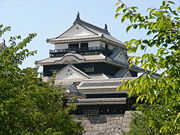
Iyo-Matsuyama Domain
Encyclopedia

Han (Japan)
The or domain was the name of the estate belonging to a warrior in Japan after the 17th century. The fiefs of the daimyos of the samurai class of Japan during the Edo period were called han.-Edo period:...
of the Edo period
Edo period
The , or , is a division of Japanese history which was ruled by the shoguns of the Tokugawa family, running from 1603 to 1868. The political entity of this period was the Tokugawa shogunate....
, with its holdings centered in modern-day Matsuyama, Ehime
Matsuyama, Ehime
is the capital city of Ehime Prefecture on the Shikoku island of Japan. It is located on the northeastern portion of the Dōgo Plain. Its name means "pine mountain." The city was founded on December 15, 1889....
.
History
The Iyo-Matsuyama domain passed through several hands before settling as the fief of a branch of the Hisamatsu-Matsudaira. In the Bakumatsu period, the domain took part in the Tokugawa shogunate's military campaign against Chōshū. During the Boshin WarBoshin War
The was a civil war in Japan, fought from 1868 to 1869 between forces of the ruling Tokugawa shogunate and those seeking to return political power to the imperial court....
, Iyo-Matsuyama sided with the Kyoto government. The domain was disbanded in 1871.
Harada Sanosuke
Harada Sanosuke
was a Japanese warrior who lived in the late Edo period. He was the 10th unit captain of the Shinsengumi, and died during the Boshin War.-Background:...
of the Shinsengumi
Shinsengumi
The were a special police force of the late shogunate period.-Historical background:After Japan opened up to the West following U.S. Commodore Matthew Perry's visits in 1853, its political situation gradually became more and more chaotic...
was the son of a low-ranking Iyo-Matsuyama retainer.
List of lords
- Katō clan, 1600-1627 (TozamaTozamaA ' was a daimyo who was considered an outsider by the rulers of Japan. The term came into use in the Kamakura period and continued until the end of the Edo period.-Edo period:...
; 200,000 kokuKokuThe is a Japanese unit of volume, equal to ten cubic shaku. In this definition, 3.5937 koku equal one cubic metre, i.e. 1 koku is approximately 278.3 litres. The koku was originally defined as a quantity of rice, historically defined as enough rice to feed one person for one year...
)
- YoshiakiKato Yoshiakiwas a Japanese daimyo of the late Sengoku Period to early Edo Period who served as lord of the Aizu Domain. A retainer of Toyotomi Hideyoshi, he fought in the battle of Shizugatake in 1583, and soon became known as one of the shichi-hon-yari , or Seven Spears of Shizugatake, Hideyoshi's seven most...
- Gamō clan, 1627-1634 (TozamaTozamaA ' was a daimyo who was considered an outsider by the rulers of Japan. The term came into use in the Kamakura period and continued until the end of the Edo period.-Edo period:...
; 240,000 kokuKokuThe is a Japanese unit of volume, equal to ten cubic shaku. In this definition, 3.5937 koku equal one cubic metre, i.e. 1 koku is approximately 278.3 litres. The koku was originally defined as a quantity of rice, historically defined as enough rice to feed one person for one year...
)
- Tadachika
- Matsudaira (Hisamatsu) clanMatsudaira clanThe was a Japanese samurai clan that claimed descent from the Minamoto clan. It first originated in and took its name from Matsudaira village, in Mikawa Province . Over the course of its history, the clan produced many branches, most of which also centered around Mikawa Province...
, 1635-1871 (ShinpanShinpan (daimyo)The daimyo were certain relatives of the Tokugawa shoguns of Japan. While all shinpan were relatives of the shogun, not all relatives of the shogun were shinpan; an example of this is the Matsudaira clan of the Okutono Domain. The shinpan lords were also known as kamon daimyō — non-daimyo...
; 150,000 kokuKokuThe is a Japanese unit of volume, equal to ten cubic shaku. In this definition, 3.5937 koku equal one cubic metre, i.e. 1 koku is approximately 278.3 litres. The koku was originally defined as a quantity of rice, historically defined as enough rice to feed one person for one year...
)
- Sadayuki
- Sadayori
- Sadanaga
- Sadanao
- Sadahide
- Sadataka
- Sadakatsu
- Sadakiyo
- Sadakuni
- Sadanori
- Sadamichi
- Katsuyoshi
- Katsushige
- Sadaaki
- Katsushige

